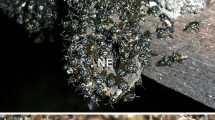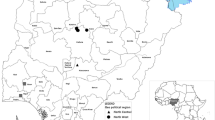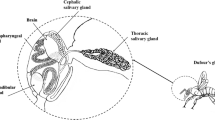Abstract
Volatile lipids from the mandibular gland secretions of bees (Hymenoptera: Apoidea) are potent olfactory repellents of foraging ants (Formica, Crematogaster) in biologically relevant contexts and quantities. In contrast, differential success in capture of bee and fly prey by predatory asilid flies (Efferia), reduviid bugs (Apiomerus), and arachnids (Agelenopsis, Argiope) is better explained by prey size than by chemical repellence, aposematism, or possession of a sting. Supernormal doses of some allomones, applied to worker honeybees (Apis mellifera) that were fed toArgiope aurantia spiders, elicted more frequent preenvenomation pauses following ensnarement but did not significantly increase other prey-handling times. These pauses merely delayed the bee's demise. Mandibular gland secretions of solitary bees augment their other secondary defenses in at least two contexts:
-
(1)
during intranest encounters when repelling intruding ants, and
-
(2)
retaliation delivered to their arthropodan predators which, if the bee is nearly too large for the predator to handle, may allow the bee to escape.
Similar content being viewed by others
References
Bergmark, L., Borg-Karlson, A.-K., andJ. Tengö. 1984. Female characteristics and odour cues in mate recognition inDasypoda altercator (Hym., Melittidae). pp. 137–143,in The Ecological Station of Uppsala University on Oland 1963–1983. Almqvist and Wiksell, Stockholm, Sweden.
Bergström, G., andTengö, J. 1973. Geranial and neral as main components in cephalic secretions of four species ofProsopis (Hym., Apidae),Zoon Suppl. 1:55–59.
Bergström, G., andTengö, J. 1978. Linalool in mandibular gland secretion ofColletes bees (Hymenoptera: Apoidea).J. Chem. Ecol. 4:437–449.
Bergström, G., Tengö, J., Reith, W., andFrancke, W. 1982. Multicomponent mandibular gland secretions in three species ofAndrena bees (Hym., Apoidea).Z. Naturforsch. 37c:1124–1129.
Bilsing, S.W. 1920. Quantitative studies in the food of spiders.Ohio J. Sci. 20:215–260.
Blum, M.S. 1966. Chemical releasers of social behavior. VIII. Citral in the mandibular gland secretion ofLestrimelitta limao.Ann. Entomol. Soc. Am. 59:962–964.
Blum, M.S. 1981. Chemical Defenses of Arthropods. Academic Press, New York. 562 pp.
Blum, M.S., andBohart, G.E. 1972. Neral and geranial: Identification in a colletid bee.Ann. Entomol. Soc. Am. 65:274–275.
Bristowe, W.S. 1941. The Comity of Spiders, Vol. II. The Ray Society. 1968. Johnson Reprint Co. Ltd., New York.
Bohart, G.E. 1970. The Evolution of Parasitism Among Bees. Faculty Honor Lectures, Utah State University, Logan, Utah, 33 pp.
Bromley, S.W. 1948. Honey-bee predators.J. N.Y. Entomol. Soc. 56:195–199.
Cane, J.H. 1981. Dufour's gland secretion in the cell linings of bees (Hymenoptera: Apoidea).J. Chem. Ecol. 7:403–410.
Cane, J.H. 1983. Olfactory evaluation ofAndrena host nest suitability by kleptoparasiticNomada bees (Hymenoptera: Apoidea).Anim. Behav. 31:138–144.
Cane, J.H., andMichener, C.D. 1984. Chemistry and function of mandibular gland products of bees of the genusExoneura (Hymenoptera, Anthophoridae).J. Chem. Ecol. 9:1525–1531.
Cane, J.H., andTengö, J.O. 1981. Pheromonal cues direct mate-seeking behaviors of maleColletes cunicularius (Hymenoptera: Colletidae).J. Chem. Ecol. 7:427–436.
Cane, J.H., Gerdin, S., andWife, G. 1983. Mandibular gland secretions of solitary bees (Hymenoptera: Apoidea): Potential for nest cell disinfection.J. Kans. Entomol. Soc. 56:199–204.
Caron, D.M. 1978. Pages 158–196,in R.A. Morse (ed.). Honey Bee Pests, Predators, and Diseases. Cornell University Press, Ithaca, N.Y.
Cederberg, B. 1977. Chemical basis for defense in bumble bees, p. 77in Proceedings, 8th International Congress IUSSI. Center for Agricultural Publishing and Documentation, Wageningen, The Netherlands.
Conover, W.J. 1980.Practical Nonparametric Statistics. John Wiley & Sons, New York. 493 pp.
Dennis, D.S., andLavigne, R.J. 1975. Comparative behavior of Wyoming robber flies II (Diptera: Asilidae).Univ. Wyo. Agric. Exp. Stn. Sci. Monogr. 30:68 pp.
Dennis, D.S., Roehrkasse, G.P., andLavigne, R.J. 1975. Prey recognition byEfferia frewingi (Diptera: Asilidae).Ann. Entomol Soc. Am. 68:404–408.
Duffield, R.M., Fernandes, A., McKay, S., Wheeler, J.W. andSnelling, R.R. 1980. Chemistry of the exocrine secretions ofHylaeus modestus (Hymenoptera: Colletidae).Comp. Biochem. Physiol. 67B:159–162.
Duffield, R.M., Harrison, S.E., Maglott, D., Ayorinde, F.O., andWheeler, J.W. 1983. Exocrine secretions of bees. V. Terpenoid esters in the Dufour's secretions ofPanurginus bees (Hymenoptera: Andrenidae).J. Chem. Ecol. 9:277–283.
Edmunds, M. 1974. Defence in Animals. Longman Group Ltd., Essex, U.K. 358 pp.
Erickson, E.H., Enns, W.R., andWerner, F.G. 1976. Bionomics of the bee-associated Meloidae (Coleoptera); bee and plant hosts of some nearctic meloid beetles—a synopsis.Ann. Entomol. Soc. Am. 69:659–670.
Evans, H.E., andLin, C.S. 1959. Biological observations on digger wasps of the genusPhilan thus.Wasmann J. Biol. 17:115–132.
Fabré, J.H. 1912. The Life of the Spider. Translated by A.T. de Mattos. Blue Ribbon Books, Inc., New York.
Gelperin, A. 1968. Feeding behavior of the preying mantis: A learned modification.Nature 219:399–400.
Hefetz, A. 1983. Function of secretion of mandibular gland of male in territorial behavior ofXylocopa sulcatipes (Hymenoptera: Anthophoridae).J. Chem. Ecol. 9:923–931.
Hefetz, A., Batra, S.W.T., andBlum, M.S. 1979a. Chemistry of the mandibular gland secretion of the Indian bee,Pithitis smaragdula.J. Chem. Ecol. 5:753–758.
Hefetz, A., Batra, S.W.T., andBlum, M.S. 1979b. Linalool, neral and geranial in the mandibular glands ofColletes bees—an aggregation pheromone.Experientia 35:319–320.
Hefetz, A., Eickwort, G.C., Blum, M.S., Cane, J., andBohart, G.E. 1982. A comparative study of the exocrine products of cleptoparasitic bees (Holcopasites) and their hosts (Calliopsis) (Hymenoptera: Anthophoridae, Andrenidae).J. Chem. Ecol. 8:1389–1397.
Hutchinson, G.E. 1978. An Introduction to Population Ecology. Yale University Press, New Haven, Connecticut. 260 pp.
Lavigne, R.J., andHolland, F.R. 1969. Comparative behavior of eleven species of Wyoming robber flies (Diptera: Asilidae).Univ. Wyo. Agric. Exp. Stn. Sci. Monogr. 18:1–61.
Linsley, E.G. 1960. Ethology of some bee- and wasp-killing robber flies of southeastern Arizona and western New Mexico.Univ. Calif. Publ. Entomol. 16:357–392.
Linsley, E.G., andZavortink, T.J. 1977. Attraction of femaleColletes louisae bees to netted, conspecific females (Hymenoptera: Apoidea).Wasmann J. Biol. 35:144–148.
Michener, C.D. 1974. The Social Behavior of the Bees. Harvard University Press, Cambridge, Massachusetts. 404 pp.
Nedel, J.O. 1960. Morphologie und Physiologie der Mandibeldrüse einiger Bienen-Arten (Api-dae).Z. Morphol. Oekol. Tiere 47:139–183.
Robinson, M.H., andOlazarri, J. 1971. Units of behavior as complex sequences in the predatory behavior ofArgiope argentata.Smithson. Contrib. Zool. 65:1–36.
Robinson, M.H., Mirich, H., andTurner, O. 1969. The predatory behavior of some araneid spiders and the origin of immobilization wrapping.Psyche 76:487–501.
Schultz, G.W. 1977. The effects of ants (Pogonomyrmex,Leptothorax, Solenopsis) on the alkali bee,Nomia melanderi.Proc. Wash. Entomol. Soc. 39:514.
Smith, B.H., andRoubik, D.W. 1983. Mandibular glands of stingless bees (Hymenoptera: Apidae): Chemical analysis of their contents and biological function in two species ofMelipona.J. Chem. Ecol. 9:1465–1472.
Sokal, R.R., andRohlf, F.J. 1969. Biometry. W.H. Freeman, San Francisco, 776 pp.
Stephen, W.P., Bohart, G.E., Torchio, P.F. 1969. The Biology and External Morphology of Bees. Oregon State University Press, Corvallis, Oregon. 140 pp.
Suter, S.B. 1978.Cyclosa turbinata (Araneidae): Prey discrimination via web-borne vibrations.Behav. Ecol. Sociobiol. 3:283–296.
Tengö, J. 1979. Odour-released behaviour inAndrena male bees (Apoidea, Hymenoptera).Zoon 7:15–48.
Tengö, J., andBergström, G. 1976. Comparative analyses of lemon-smelling secretions from heads ofAndrena F. (Hymenoptera; Apoidea) bees.Comp. Biochem. Physiol. 55B:179–188.
Tengö, J., andBergström, G. 1977. Comparative analyses of complex secretions from heads ofAndrena bees (Hym.:Apoidea).Comp. Biochem. Physiol. 57B:197–202.
Usinger, R.L. 1958. Harwanzen or “resin bugs” in Thailand.Pan-Pac. Entomol. 34:52.
Vinson, S.B., Williams, H.J., Frankie, G.W., Wheeler, J.W., Blum, M.S., andCoville, R.E. 1982. Mandibular glands of maleCentris adani (Hymenoptera: Anthophoridae): Their morphology, chemical constituents, and function in scent marking and territorial behavior.J. Chem. Ecol. 8:319–328.
Weaver, E.C., Clarke, E.T., andWeaver, N. 1975. Attractiveness of an assassin bug to stingless bees.J. Kans. Entomol. Soc. 48:17–18.
Wheeler, J.W., Blum, M.S., Daly, H.V., Kislow, C.J., andBrand, J.M. 1977. Chemistry of mandibular gland secretions of small carpenter bees.Ann. Entomol. Soc. Am. 70:635–636.
Author information
Authors and Affiliations
Rights and permissions
About this article
Cite this article
Cane, J.H. Predator deterrence by mandibular gland secretions of bees (Hymenoptera: Apoidea). J Chem Ecol 12, 1295–1309 (1986). https://doi.org/10.1007/BF01012349
Received:
Accepted:
Issue Date:
DOI: https://doi.org/10.1007/BF01012349




